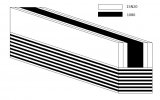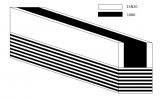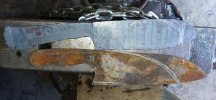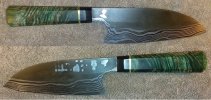-
The BladeForums.com 2024 Traditional Knife is available! Price is $250 ea (shipped within CONUS).
Order here: https://www.bladeforums.com/help/2024-traditional/
You are using an out of date browser. It may not display this or other websites correctly.
You should upgrade or use an alternative browser.
You should upgrade or use an alternative browser.
Butchers knife for a friend - WIP
- Thread starter weo
- Start date
weo
Basic Member
- Joined
- Sep 21, 2014
- Messages
- 3,099
weo
Basic Member
- Joined
- Sep 21, 2014
- Messages
- 3,099
Stacy E. Apelt - Bladesmith
ilmarinen - MODERATOR
Moderator
Knifemaker / Craftsman / Service Provider
- Joined
- Aug 20, 2004
- Messages
- 38,290
I would not taper it since there is a core along the spine and you certainly would not want to grind into it.
weo
Basic Member
- Joined
- Sep 21, 2014
- Messages
- 3,099
I'm not sure I'm following why. I built it this way so that the pattern will look like cloudy skies over a river. I was thinking tapering it at least to around 3mm (0.125") at the tip.I would not taper it since there is a core along the spine and you certainly would not want to grind into it.
Wouldn't a 5mm (0.210") spine the whole way make for an extra heavy knife? Or is that thickness needed for popping joints open?
Stacy E. Apelt - Bladesmith
ilmarinen - MODERATOR
Moderator
Knifemaker / Craftsman / Service Provider
- Joined
- Aug 20, 2004
- Messages
- 38,290
I agree that the knife is very thick. What I was referring to is the upper part is three layers with the outer layers much thinner than the core. If you taper the blade you may grind right through the outer layers and expose the darker core. This would run your "cloudy skies over the river" thing.
Honestly, I don't get your visual theme, but that doesn't matter. I look forward to seeing how it comes out.
Honestly, I don't get your visual theme, but that doesn't matter. I look forward to seeing how it comes out.
weo
Basic Member
- Joined
- Sep 21, 2014
- Messages
- 3,099
Perhaps I should have noted that the sketch of the billet was not to scale, but I am a little worried that I didn't make the outer 15N20 layers thick enough. The original stack was two 0.070" thick pieces of 15N20 on the sides sandwiching 3 pieces of .125" 1080 in the center.If you taper the blade you may grind right through the outer layers and expose the darker core. This would run your "cloudy skies over the river" thing.

weo
Basic Member
- Joined
- Sep 21, 2014
- Messages
- 3,099
Well, I finally got an answer from the end user, sort of... "I want it thick, so I'll leave it up to you to decide where to start tapering."
Because this is so far outside the box for me (my brain is used to thinking, thinner, thinner...), I would appreciate any advice.
Should I keep the whole spine at 5mm or taper it to ~3mm at the tip?
How thick should I keep the edge before quenching and sharpening?
Also, should I keep a full tang to help with the balance and not worry about the overall weight?
Thanks
Because this is so far outside the box for me (my brain is used to thinking, thinner, thinner...), I would appreciate any advice.
Should I keep the whole spine at 5mm or taper it to ~3mm at the tip?
How thick should I keep the edge before quenching and sharpening?
Also, should I keep a full tang to help with the balance and not worry about the overall weight?
Thanks
weo
Basic Member
- Joined
- Sep 21, 2014
- Messages
- 3,099
- Joined
- Jun 3, 2019
- Messages
- 2,714
Clouds over river. I get it. Cool
weo
Basic Member
- Joined
- Sep 21, 2014
- Messages
- 3,099
Here it is after final grinding and etched before adding the handle. Waiting for color choices from the end user.

The pattern isn't quite what I was hoping for, not really cloudy but I think I know what to do differently next time, so I'm learning and that's a good thing, right? I used 2 pieces of 1080 in the spine portion, and next time will only use one piece.
I used 2 pieces of 1080 in the spine portion, and next time will only use one piece.

The pattern isn't quite what I was hoping for, not really cloudy but I think I know what to do differently next time, so I'm learning and that's a good thing, right?
- Joined
- Jun 3, 2019
- Messages
- 2,714
Nice! What is the bolster materiai? What thickness for the spacer (I’m still struggling settling on a thickness for that...)
weo
Basic Member
- Joined
- Sep 21, 2014
- Messages
- 3,099
Good morning, Cush, thanks. The bolster is some ebony that I got from a friend who's luthier brother died a number of years ago. It was originally a 2" square block by 6" long, I'm now down to only about 2" left.
The spacer is 3/32", I think, but it might have been 1/8" before sanding it flat before glue up. It's just a 1" wide brass strip that I got at a hardware or hobby store a few years ago. Should be pretty easy to find.
The spacer is 3/32", I think, but it might have been 1/8" before sanding it flat before glue up. It's just a 1" wide brass strip that I got at a hardware or hobby store a few years ago. Should be pretty easy to find.
- Joined
- Jun 3, 2019
- Messages
- 2,714
Thanks william. I asked about the spacer material because I started out with thinner material, and it was a real pain to try to get a reasonable hole drilled into it....
weo
Basic Member
- Joined
- Sep 21, 2014
- Messages
- 3,099
When you drill through thin material, do you use a backer block of wood or something similar?it was a real pain to try to get a reasonable hole drilled into it....
- Joined
- Jun 3, 2019
- Messages
- 2,714
yes. it wants to get about 3/4 of the way through drilling the hole, then tries to wrap up the material around the bit. smaller holes no problem .... the bigger holes like 3/8" are what cause problems.When you drill through thin material, do you use a backer block of wood or something similar?
yes. it wants to get about 3/4 of the way through drilling the hole, then tries to wrap up the material around the bit. smaller holes no problem .... the bigger holes like 3/8" are what cause problems.
Clamp the thin material between two pieces of scrap wood when drilling the hole. Or use a step drill. Or glue your material down to some scrap with CA glue, drill the hole, then release it with acetone. Twist drills, especially large ones, are terrible at drilling thin materials so you have to help them out by supporting the workpiece properly. Just putting it on top of a piece of scrap isn’t enough to get a clean hole.





